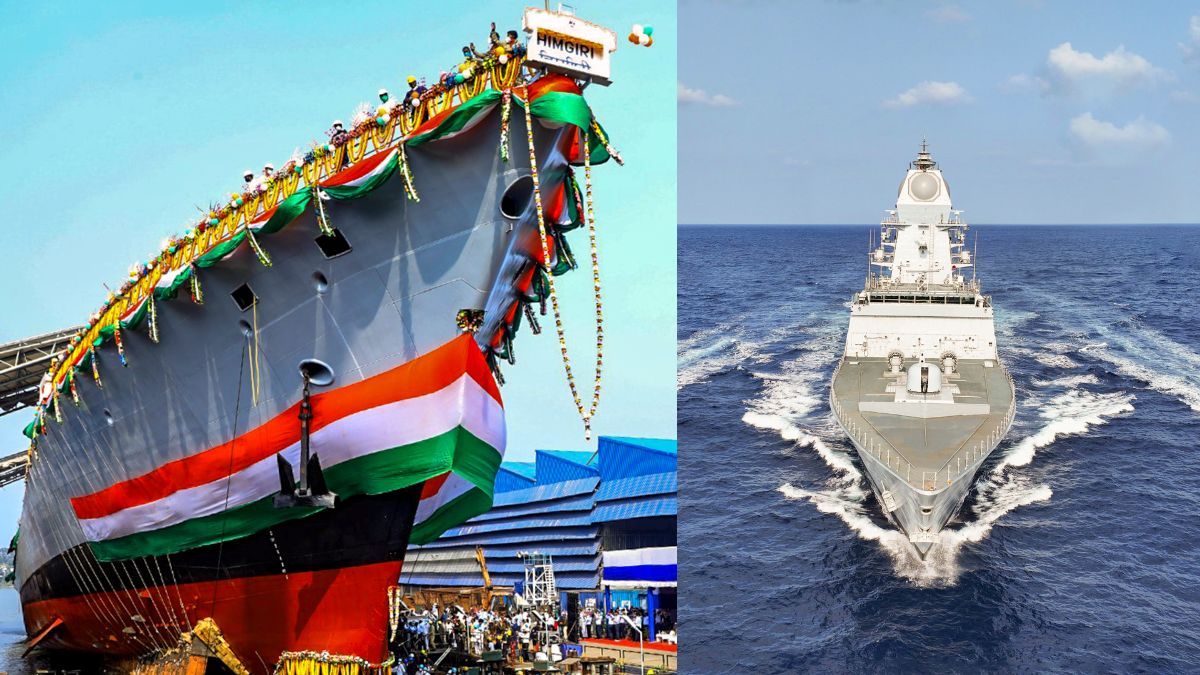The Indian Navy is commissioning two indigenously built stealth frigates – INS Udaygiri and INS Himgiri – simultaneously on Tuesday (August 26) at Visakhapatnam in Andhra Pradesh. Part of the Project 17 Alpha (P-17A), both stealth frigates are a big boost to India’s maritime defence.
INS Nilgiri , the first warship of the Project 17A, was commissioned earlier this year with Prime Minister Narendra Modi in attendance. These frigates are a successor of the Shivalik-class frigates of Project 17 (P-17).
Here’s how the new warships will add to India’s defence.
Commissioning of INS Udaygiri, Himgiri
INS Udaygiri and INS Himgiri are being commissioned together into the Indian Navy’s fleet today.
INS Udaygiri is the second ship of the Project 17A stealth frigates that have a budget of Rs 45,000 crore.
The P-17A warships are among the first in India to be developed using “integrated modular construction,” under which several pre-outfitted blocks are assembled, which reduces construction time and improves quality control, as per ThePrint.
While INS Udaygiri was constructed by Mumbai-based Mazagon Dock Shipbuilders Limited (MDL), INS Himgiri is the first of the Nilgiri class to be built by Kolkata-based Garden Reach Shipbuilders & Engineers (GRSE), according to the Ministry of Defence.
Why these stealth frigates are special
Displacing over 6,700 tonnes, the two stealth frigates are nearly five per cent larger than their Shivalik-class predecessors. However, they still have a sleeker hull form with a reduced radar cross-section.
INS Udaygiri and Himgiri are powered by a Combined Diesel and Gas (CODAG) propulsion system, which includes two diesel engines and two gas turbines.
Managed through an Integrated Platform Management System (IPMS), it allows speeds over 28 knots and an endurance of about 5,500 nautical miles.
“These multi-mission frigates are capable of operating in a ‘blue water’ environment — referring to the open ocean — dealing with both conventional and non-conventional threats in the area of India’s maritime interests,” the Defence Ministry said in a statement in July about Project 17A’s warships.
Sources told ThePrint that the two stealth frigates boast features such as an enclosed mooring deck, a low infrared signature, and a deck rail system, enabling safe movement of crew and equipment. This design gets rid of the need for guardrails, thus enhancing the frigates’ stealth characteristics.
⚓ INS Udaygiri — United. Ultimate. Unbeatable.
— IN (@IndiannavyMedia) August 24, 2025
Stealth in design, strength in capability, and spirit in her crew.
Astride tradition and technology, a new era begins.
🎥 Watch the journey of #INSUdaygiri.
Commissioning on 26 Aug 2025, #Visakhapatnam. 🌊@IndianNavy@IN_WNC… pic.twitter.com/z5N3ttvKhF
“The superstructure of these frigates uses composite materials with radar-absorbent coatings to reduce the radar cross-section. The enclosed decks and flush-mounted weapons minimise signatures, while the exhausts are fitted with infrared suppression systems to cut heat emissions. Collectively, these measures significantly lower the ships’ radar, infrared and acoustic profiles,” a source said.
The frigates are equipped with a number of weapons, including the BrahMos supersonic missile, the Indo-Israeli Barak-8 naval long-range surface-to-air missile system (LRSAM), 76 mm naval guns, and torpedoes for undersea warfare.
“These frigates give India a qualitative edge. Their extended range of 5,500 nautical miles and helicopter-borne anti-submarine warfare (ASW) capabilities allow patrols in distant waters and enable power projection alongside India’s aircraft carriers,” a source was quoted as saying by ThePrint.
#INSHimgiri : अदृश्यम अजयम
— SpokespersonNavy (@indiannavy) August 25, 2025
Invisible and Invincible
The legacy of the name #Himgiri is distinguished by honour; its modern incarnation radiates unprecedented strength.
Witness the evolution of #Himgiri — from blueprints to the boundless blue of the sea.
A proud heritage reborn… pic.twitter.com/tw2MqTtWHQ
Developed by Bharat Electronics Limited (BEL), the frigates incorporate the Hull Mounted Sonar Advanced – Next Generation (HUMSA-NG) sonar, which can detect submarines and underwater threats by providing early-warning data to anti-submarine weapons.
The on-board sensors are integrated through the CMS-17A (combat management system), which performs the function of the frigate’s central command hub.
The Ajanta and Shakti suites of the frigates will help in electronic warfare. Developed by BEL and the Defence Research and Development Organisation (DRDO), they can catch enemy radar and communication signals and jam them.
The two warships are equipped with the Kavach chaff rocket launcher, an anti-missile naval decoy system. They also have the Maareech Torpedo Decoy System, which emits acoustic decoys to mislead enemy torpedoes.
Each frigate can carry around 225 personnel and ship-borne helicopters for long-range anti-submarine and surveillance missions.
How Nilgiri-class frigates strengthen India’s defence
The Indian Navy will deploy P-17A frigates alongside Delhi-class destroyers and Shivalik-class frigates. With this, the armed force will expand its operational reach in the Indian Ocean Region (IOR).
As per ThePrint sources in the Navy, at least four more indigenously built P-17A frigates —Taragiri, Mahendragiri, Dunagiri and Vindhyagiri — are expected to be commissioned over the next year.
These warships would protect the sea trade routes, as well as make India’s naval presence felt in the Indian Ocean region from the Strait of Malacca to Africa, officials said, reported NDTV.
“As the nation watches the two grey hulls take their place in the fleet, the message will be clear: India’s oceans are guarded by ships built in India, designed by Indians and staffed by Indians - a true embodiment of the Make in India initiative and a beacon of the country’s rising maritime power,” the Ministry of Defence said.
With inputs from agencies


)

)
)
)
)
)
)
)
)



